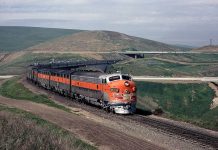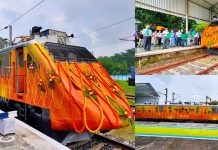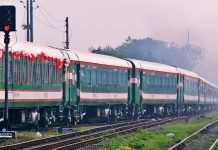9 kms in 40 mins: India’s shortest passenger train service likely to be taken off rails
The sun had begun to set over the Arabian Sea on Monday evening by the time the three-coach Diesel Electrical Multiple Unit (DEMU) train honked to signal its departure from the Cochin Harbour Terminus (CHT) station. A couple of minutes past 5 pm — its scheduled departure time, the train had lingered on for just a bit at the station, waiting for two men, in their 50s, as they huffed and puffed and clambered onto one of its coaches at the last minute.
Normally a train wouldn’t wait for two ordinary passengers even a minute, but this particular train can certainly afford to. For unlike its peers, it doesn’t have miles to go before it can rest. It’s destination is just nine kilometres away — a distance it traverses in 40 minutes with one stoppage, lending this DEMU train the unique distinction of being the country’s shortest railway service. What’s more, on Monday evening, when it began its service from CHT, the three coaches of the train had exactly 12 passengers out of a seating capacity of 300. Such abysmally low passenger patronage explains why the Railways is most likely to pull the train off the tracks, less than a week after its introduction.




“This was a trial run between CHT and Ernakulam Junction. We were reviewing the service and we are actually planning to cancel the service. If there are no takers for it, what’s the use of running it? Less than 15 tickets are sold in a day,” said SK Sinha, the Divisional Railway Manager (DRM) in Thiruvananthapuram.
The green-liveried DEMU currently shuttles twice a day in the morning and evening hours between CHT, located on Willingdon Island home to the Cochin Port Trust and the Southern Naval Command of the Indian Navy, and Ernakulam Junction, the principal railway station serving Kochi. The loco pilot of the train laughed out loud when asked about its popularity among commuters.
“The other day, we completed a run with two people. The day before that, I think there were four people. It’s a joke is what it is,” he said, before hoisting himself into the cab.
A technician, associated with the train, said it came as a surprise to him when the Railways announced such a short service especially on a route bustling with private bus services. “It’s always somebody higher-up who decides these things. The orders came from above and we are working. Who knows what the future of the train’s gonna be!” he sighed.
On Monday, Joseph, who works as a supervisor at the Naval Base, and his son were among the dozen passengers who settled themselves comfortably in the cushioned seats of the DEMU waiting for the ride to begin. He had paid Rs 120 for an auto rickshaw ride to reach the CHT for the simple pleasure of travelling on the train.
“I agree there’s no logic in running the train on such a short route. That’s why it should be extended, perhaps to Thrissur or Kottayam so that it can benefit the office crowd. But Railways must not stop the service at any cost,” he said.
Joseph’s attachment to the short, but scenic train route stems from the prime and glorious years of the CHT as one of Kerala’s most important railway terminals before it fell into disrepair in the early 90s. Built during the British rule and opened to the public in 1943, the CHT initially saw freight traffic from the Cochin Port and the movement of thousands of wagons containing tea, coffee and coir to be exported to countries around the world. Helmed by the British, the station in the 40s was a critical cog in the establishment and development of Cochin as a major trading hub in south India.
After Independence, the CHT got linked to the broad gauge line and became an important artery of south-east and south-west railway traffic. At its prime in the 70s and 80s, the station was a terminal point for at least 16 long-distance trains from destinations such as Bombay, Madras and Howrah. Popular trains such as the Tea Garden Express (Cochin-Ooty), Island Express (Cochin-Bangalore) and Jayanti Janata (Cochin-Bombay) used to take off from CHT every week. But once railway services were extended down south via Alappuzha and Kottayam to Thiruvananthapuram and newer stations like Ernakulam Town sprang up, the CHT ended up becoming marginalised and undermined. In 2004, by which time a single passenger train to Shoranur operated from CHT, a dredger hit the Venduruthy railway bridge leading to complete suspension of commercial services. The 14-year dry run of the British-era station came to an end last week when the DEMU chugged out of CHT to the joy of the residents of west Kochi.
The train may not get enough passengers, but the excitement of seeing it chug along the picturesque route was palpable among the locals. As it trundled at a leisurely pace of 30 km/hr, passing the Naval airport and along the busy road to Willingdon Island, children and women smiled and waved at the loco pilot. Wounding its way past brightly-painted houses and its front porches and tiny shacks selling tea and hot snacks, the train, in many ways, seemed to breathe life into these parts of west Kochi.
“When I was young, a large number of private firms used to operate at Willingdon Island. Now, they are all shut down. Also, you had the Port and the Navy. I remember boarding trains to Trichy from the CHT among massive crowds. Buses were very few at that time. Travelling by train was a thrill in those days,” said Ashraf Ali, a resident of Mattanchery, who boarded the DEMU with his friend Babu simply to relive those days.
Peering out from the door, Ali, who worked for decades at the now-defunct goods shed at CHT, took in those sights again, although he admitted the landscape has changed a lot. Where large swamps once stood, elaborate residential apartment buildings have cropped up with their extensive parking bays.
While the DEMU’s future is uncertain, Railway officials indicated that heritage train services primarily aimed at tourists on the section between Ernakulam Jn and CHT was on the charts.
“We are trying to get a steam locomotive from the Southern Railways. If we can run some heritage trains on weekends perhaps, it will attract some tourists. We will continue to maintain the CHT station. There’s a computerised reservation ticket counter. We have also done all the track and signalling work at the station,” said Sinha.
But once the DEMU is withdrawn, will the station go back into obscurity? “No, no, we will continue to maintain the CHT station. Right now, there’s an advanced reservation ticket counter. We have also completed all the track and signalling work at the station,” he added.
On Monday evening, as the DEMU finally rolled into platform 1 at the busy and chaotic Ernakulam Jn station at the end of its short journey, a light drizzle had begun. There’s a 30-minute wait before it begins its fourth and final service of the day, back to the CHT. While commuters could be seen dashing to catch trains on other platforms, nobody seemed to mind the DEMU on platform 1. At one point, the train may have to go back to CHT without even a single passenger.
After about 20 minutes, a woman and her teenage son boarded the train, looked around nervously at the other empty coaches and settled themselves in one of the seats. When asked if she was taking the train to commute to Willingdon Island, she replied with a sheepish grin, “No, no. I live right here. My son is very fond of trains. Someone told me this is a short service so we got on it.”
© Vishnu Varma – Indian Express.



















